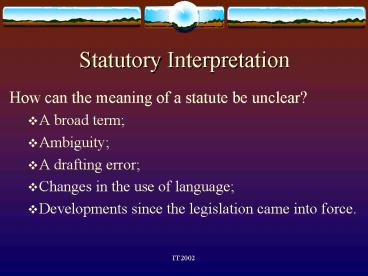Statutory Interpretation - PowerPoint PPT Presentation
1 / 12
Title:
Statutory Interpretation
Description:
The common law has not changed unless the statute shows a clear intention to change it; ... R v. Harris (1836)- ...cut, stab or wound...' Give me back my nose! ... – PowerPoint PPT presentation
Number of Views:601
Avg rating:3.0/5.0
Title: Statutory Interpretation
1
Statutory Interpretation
- How can the meaning of a statute be unclear?
- A broad term
- Ambiguity
- A drafting error
- Changes in the use of language
- Developments since the legislation came into
force.
2
Statutory Interpretation
- Presumptions
- Rules of Statutory interpretation
- Literal rule
- Golden rule
- Mischief rule
- Purposive approach
- Rules of language
- Ejusdem generis
- Nosciter a sociis
- Expresso unius exclusion alterius
- Aids to Statutory interpretation
- Intrinsic
- Extrinsic
3
Presumptions
- A useful starting point!
- A court will presume that
- The common law has not changed unless the statute
shows a clear intention to change it - An accused requires mens rea in criminal cases
- A statute does not intend to be retrospective
(that is, makes illegal something that was legal
at the time it was done) unless it specifically
states such intent.
4
Statutory Interpretation- Literal rule
- Words of a statute are given their ordinary,
plain or literal meaning, regardless of whether
this leads to an absurd result. - If the words of an Act are clear then you must
follow them even though they lead to a manifest
absurdity. The court has nothing to do with
whether the legislature has committed an
absurdity. Per Lord Esher, R v. Judge of the
City of London Court (1892) - Whitely v. Chappell (1868)- impersonate any
person entitled to vote Can the dead vote? - R v. Greenburg- dishonest appropriation
Petrol station theft. - R v. Harris (1836)- cut, stab or wound Give
me back my nose! - London and Noth Eastern Railway v. Berriman 1946
5
Statutory Interpretation- Golden rule
- Gives words their literal meaning. If this
would produce an absurd result, another
interpretation can be given. Two forms of this
rule - Narrow application- court can only choose between
the possible meanings of a word or phrase. R v.
Allen (1872)- marry Legally, or the marriage
service? - Wider application- court can modify words in a
statute to avoid an absurd result. Re Sigsworth
(1935)- does the law allow a murderer to inherit?
6
Statutory Interpretation- Mischief rule
- Court should consider
- Common law before the Act
- What was the defect in the common law?
- What was the remedy Parliament had resolved?
- What was the true reason for the remedy?
- The court can then interpret the statute to
ensure the mischief is suppressed. - Smith v. Hughes (1960) Prostitutes in a street
or public place - Milnes v. Cooper (1967) a gypsy who pitches a
booth, stall, or stand on a highway shall be
guilty of an offence
7
Statutory Interpretation- Purposive approach
- Favoured by European Courts. Wider than the
mischief rule in application. Courts should
consider what Parliament intended to be the
purpose of the statute, and apply it to the
present case. - Lord Denning in Magor and St. Helens v. Newport
Corporation We sit here to find out the
intention of Parliament and of ministers and
carry it out, and we do this better by filling
the gaps and making sense of the enactment than
by opening it up to destructive analysis. - Criticised by Lord Scarman- We are not bound by
Parliaments intentions but Parliaments
enactments.
8
Rules of language- Ejusdem generis
- Relating to the same kind.
- Where a list of words is followed by general
words, then the general words are limited to the
same kinds of items as the specific words. - Powell v. Kempton Park Racecourse (1899)
- Flack v. Baldry (1988)
9
Rules of language- Nosciter a sociis
- A word is known by the company it keeps.
- Look at words in their context and interpret
accordingly- look at other words in the same
section or other sections in the Act to discover
the true meaning of the words in question. - Bromley London Borough Council v. GLC (1983)
- R. v. Harris (1836)
10
Rules of language- Expresso unius exclusio
alterius
- The mention of one thing excludes others.
- Where a list of words is not followed by general
words, then the Act only applies to the items in
the list. - Tempest v. Kilner 1846
11
Intrinsic aids to interpretation
- Help that can be found within a statute.
- Long title (R v. Galvin (1987)
- Inclusory words or lists (Coltman v. Bibby
Tankers (1988)) - Statements of principle within the Act
12
Extrinsic aids to interpretation
- Help that can be found outside a statue.
- Dictionaries
- Explanatory notes
- Other statues
- Previous case law
- Hansard
- Historical setting
- Reports of law reform bodies
- International conventions, treaties, directives,
regulations.

